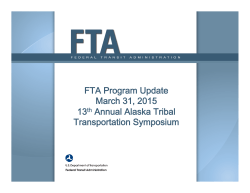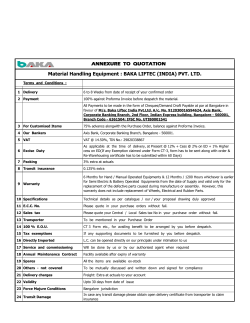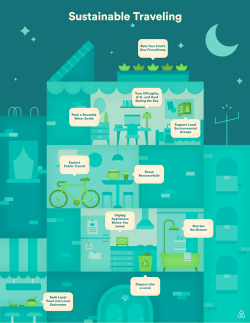
Slide 0 - California Transit Association
Transit 101 A Legislative Briefing March 24, 2015 Sacramento, CA Welcome and Opening Remarks Donna DeMartino General Manager/Chief Executive Officer San Joaquin Regional Transit Executive Committee Chair California Transit Association Introduction to Transit in California Joshua W. Shaw Executive Director California Transit Association Matt Robinson Legislative Advocate California Transit Association Overview • California transit systems maintain and operate nearly 20k transit vehicles – 3 of country’s 15 largest transit fleets in California • 6 of nation’s 30 highest ridership transit services in California • In 2012, ~1.4B trips were taken on transit in California (risen since then) – Over 8B miles traveled – Second only to New York Overview • California expected to add ~10M people by 2040 – Equal to adding population of L.A. County – L.A. #1 most congested city in America • Transit is key to meeting AB 32 greenhouse gas emissions reduction goals – Transportation sector contributes 38% of GHG emissions in the state Transit Funding Needs Capital Funding – 10 Yr Need/Trend (YOE $B) 80 Operating Funding – 10 Yr Need/Trend (YOE $B) 120 70 100 $21.68B Funding Gap 60 50 $50.13B Funding Gap 80 40 Combined Service Expansion 30 Major New Service 20 Service Expansion All Uses 60 Major New Services 40 Service Expansion 20 10 Preservation Preservation 0 0 Projected Need Projected Trend Projected Need Projected Trend Federal Funding Sources • Portion of Federal excise tax on gasoline & diesel 15% of Highway Trust Fund dedicated to regional agencies and local transit providers – California received $1.75B in 2014 • Grants − Discretionary and formula grant programs authorized under SAFETEA-LU and the MAP 21 Act − Including: Bus and Bus Facilities; Clean Fuel Grant Program; New Starts, Small Starts; TIGER; Urbanized Area Formula Program State Funding Sources • Sales tax on diesel fuel (6.5% of 9.25% levied) – A portion distributed through State Transit Assistance program formula (half to RTPAs/MPOs and half to operators) – STA ~$408M in 2013-14; projected at ~$386M in 2014-15 – A portion goes to intercity rail (~$228M in 2014-15) • Bonds – Proposition 1B ($3.6B to transit; $400M to intercity rail) – Proposition 1A ($950M to rail transit) • STIP – Can only fund “mass transit fixed guideways” (rail) – Small share required for intercity rail • Cap and Trade − $180M in FY 14-15 for transit operations and capital − $25M in FY 14-15 for ZEB − All funding tied to GHG reductions Cap and Trade • Four programs available to transit agencies − Low-Carbon Transit Operations ($25M/5%) − Transit and Intercity Rail Capital Program ($25M/10%) − Affordable Housing and Sustainable Communities Program ($130M/20%) − Low-Carbon Transportation ($25M) • All programs currently underway; project applications due in spring Cap and Trade • 60% of ongoing Cap and Trade appropriations support transportation • Remaining 40% subject to annual appropriation − Directed toward investments in programs that include low carbon transportation, energy efficiency and renewable energy, and natural resources and waste diversion • FY 14-15 auction proceeds are $315M over enacted budget ($550M), possibly $1B+ available this year Current Local Funding Sources • Transportation Development Act – 0.25% of statewide sales tax on all goods goes to Local Transportation Funds – Transit in urban counties, streets & roads in rural counties – ~$1.3B in 2014-15 • Local Sales Tax Measures – 21 counties have approved sales tax measures for transportation – 4 transit authorities have approved permanent local tax measures – ~$3.8B in 2014-15 • Transit Fares – Provides ~$1.2B for local transit systems • Special Benefits Assessments/ Developer Impact Fees Policies should guide transportation investments • AB 32 (the California Global Warming Solutions Act of 2006) – Requires reduction of GHG emissions to 1990 levels by 2020 • Executive Order S-03-05 – Requires reduction of GHG emissions to 80% below 1990 levels by 2050 • Executive Order B-16-12 – Requires transportation sector to meet its “equal share” of the 2050 GHG emissions target Policies should guide transportation investments • SB 375 (the Sustainable Communities & Climate Protection Act of 2008) − Sets regional targets for GHG emissions reduction from passenger vehicles − Requires transportation and land use planning with the goal of more sustainable communities − Promotes active transportation and transit • SB 535 – Requires at least 25% of available proceeds to be invested in projects that benefit disadvantaged communities – Requires at least 10% of available proceeds to be invested in projects located within disadvantaged communities • SB 32? – Would codify 2050 GHG target established by Executive Order S-03-05 Why is more transit needed? • Current emissions reduction strategies (SCSs and State modal plans) do not get us to our 2050 target – Actually lead to slight increase in VMT and GHG emissions due to population growth – 80% of Californians believe climate change is serious threat • It supports the economy – Provides access to jobs, education, goods and services and recreational facilities – Every $1B of investment in public transportation (capital, operations) creates approximately 21,800 jobs and adds roughly $1.7B to GDP Why is more transit needed? • Changing demographics require it – California’s population to increase to 48M by 2040, with inland areas of the State expected to grow the fastest • Examples of Pop. Increases: Kern – 92%; Madera – 84%; Riverside – 58% – 67% increase in ratio of seniors to working age people from 2010 to 2030 • The public supports it – In 2014, 42 out of 61 pro-transit measures nationwide passed – 3 measures passed in California, requiring 2/3 majority (Alameda, Monterey, San Francisco) Why is more transit needed? • Next generation demands it – Millennials are the largest generation in number – Those born in the 1990s travel 18% fewer miles and take 4% fewer automobile trips than previous generations – Percentage of HS seniors with driver’s licenses declined from 85% in 1996 to 73% in 2010 – 70% of millennials prefer to live in communities that feature multimodal transportation options How do we fund more transit? Federal Level • Fund a 2015-2020 federal transit program of not less than $100.3 billion over six years • Increase flexible funding and regulatory environment • Support additional funding for strategies that reduce GHG emissions How do we fund more transit? State Level • Increase the sales tax rate on diesel fuel − State Transit Assistance program currently receives 4.125% (est. $386M in 2014-15 and $388M in 2015-16) − Would need to lower diesel excise tax rate to remain “revenue neutral” • Direct a portion of revenues from new funding sources to transit − Road-User Charge (VMT Fee), Vehicle License/Reg. Fees, HOT Lanes, Bonds • Increase % of Cap and Trade auction proceeds going to transit – For example, take LCTOP to 10% • Increase gasoline excise tax − STIP funds can be used for mass transit fixed guideways (rail) How do we fund more transit? Local Level • Lower-vote threshold/increase cap – Measure J (Los Angeles County, 2012) and Measure B1 (Alameda County, 2012) recently failed passage with 66.1% and 66.53% approval, respectively – ACA 4 (Frazier) would lower the voter-threshold for special taxes designed to fund local transportation projects from 2/3 to 55 percent – SB 464 (Mullin) would increase the maximum combined rate of all taxes under the Transactions and Use Tax Law from 2% to 3% • Support new local financing options for infrastructure near transit – Enhanced Infrastructure Financing Districts – Special Benefits Assessments California Transit AssociationSponsored Bills • AB 1250 (Bloom) – Provisions that provided transit agencies with temporary reprieve from California’s decades-old bus axle weight limits will sunset at the end of 2015 – The expiration of these provisions impact various stakeholders, including cities, counties, public transit agencies, and private sector bus suppliers – This bill will serve as the vehicle for renewed discussion and negotiation with these stakeholders regarding a possible long-term solution to the issue California Transit AssociationSponsored Bills • SB 413 (Wieckowski) – Would allow transit agencies to use an administrative process to cite and process minors in violation of specified prohibited acts – Would make it a violation for failing to yield seating reserved for elderly and disabled individuals, and clarify what constitutes a noise violation on a transit property California Transit AssociationSponsored Bills • SB 508 (Beall) – The TDA requires transit operators to meet certain farebox recovery and operating cost criteria, irrespective of external cost pressures, in order to receive funds, for specified purposes, from the Local Transportation Fund and the State Transit Assistance program – This bill would address the challenges posed by this rigid funding mechanism by creating more flexible farebox recovery and operating cost criteria, and by rationalizing the penalties for non-compliance Public Transit and Transit Industry Suppliers: Perspectives Joshua W. Shaw Executive Director California Transit Association Panelists • David Armijo, General Manager, AC Transit • Donna DeMartino, General Manager/Chief Executive Officer, San Joaquin Regional Transit District • Kevin Kane, Executive Director, Victor Valley Transit Authority • David Kutrosky, Managing Director, Capitol Corridor Joint Powers Authority • Beth McCormick, General Manager, Orange County Transportation Authority • Joe Policarpio, Vice President of National Sales, Gillig LLC • Michael Turner, Director of Government Relations, Los Angeles County Metropolitan Transportation Authority • Michael Wiley, General Manager/Chief Executive Officer, Sacramento Regional Transit District Q&A All Transit 101 A Legislative Briefing March 24, 2015 Sacramento, CA
© Copyright 2025









